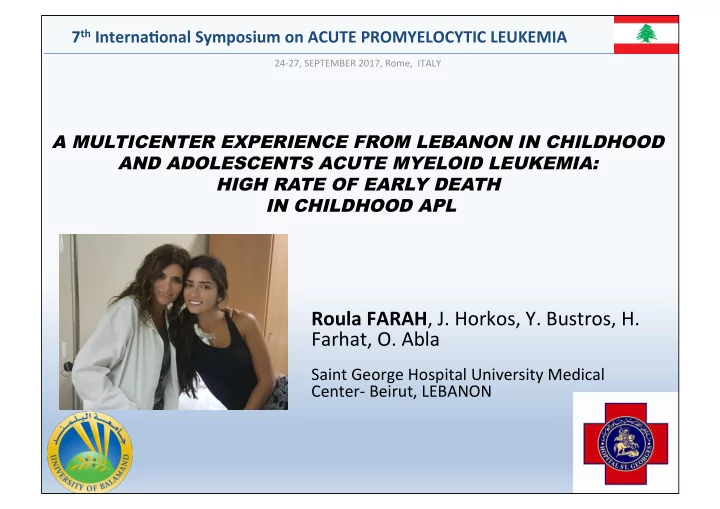

7 th Interna1onal Symposium on ACUTE PROMYELOCYTIC LEUKEMIA 24-27, SEPTEMBER 2017, Rome, ITALY A MULTICENTER EXPERIENCE FROM LEBANON IN CHILDHOOD AND ADOLESCENTS ACUTE MYELOID LEUKEMIA: HIGH RATE OF EARLY DEATH IN CHILDHOOD APL Roula FARAH , J. Horkos, Y. Bustros, H. Farhat, O. Abla Saint George Hospital University Medical Center- Beirut, LEBANON
Background: Lebanese Social & Health Facts • PopulaQon: – 4 million Lebanese – 2 million non-Lebanese refugees • 10,452 km 2 • High level of educaQon • Health care system mostly private - cancer paQents parQally covered by MOH
Lebanon Social & Health Facts • No regular Cancer staQsQcs. Incidence of AML and therefore APL unknown • Advanced Lab Tests & Transfusion Services available in terQary care centers but not ideal in small centers or rural areas • ATRA available upon request: not always present in Hospital stocks – coverage of ATRA varies
Background: AML & APL • AML is a disease with marked heterogeneity in clinical and biologic features, response to therapy and survival. • Despite major achievements in the treatment of AML, long term survival remains poor. Half of pediatric AML paQents relapse and die internaQonally. • APL is a unique subtype with disQnct biologic and molecular characterisQcs, from highly fatal 50 years ago to highly curable nowadays but sQll associated with high rates of early death and delays in diagnosis in the “real world”. • There is no published data on pediatric AML or APL in Lebanon
Objec1ves • IdenQfy: Clinical, CytogeneQc, Molecular Findings and Outcome data of pediatric AML in the Lebanese populaQon in comparison to the InternaQonal and Regional data available. • Focus the study on Childhood and Adolescent APL in Lebanon.
Methods • RetrospecQve chart review of children with AML and APL diagnosed at 3 terQary care centers in Beirut over the past ten years. • Data collecQon sheets were filled and analyzed.
DATA Collec1on Sheets • Demographic InformaQon • Date of Diagnosis and PresenQng Symptoms • Blood Analysis, Bone Marrow Aspirate, CytogeneQc Features, Molecular Biology Analysis, HLA typing • Treatment and Outcome • Data on HSCT and Long-Term Follow-up
Results: Total AML & APL Pa1ents • Twenty four paQents were diagnosed with AML from 2002-2010 , 12 girls and 12 boys. • Two had pre-exisQng Fanconi anemia, 1 Down syndrome, 1 MDS with monosomy 7, 1 secondary AML aaer treatment for Burkib’s lymphoma. • 6 (25%) had de novo APL with t(15;17) • Mean age was 8.6 years (range, 1-24) • Median WBC at dx = 31 x 10 9 /L (range, 2.1-376); PLT:46 x 10 9 /L (range, 10-164)
Results Complex Other; 4.5% AbnormaliQes; 4.1% Cytogene1c Findings inv 16; 8.3% Normal Karyotype t(15;17) t(9;11); 4.1% t(8;9) Normal t(7;11) Karyotype; 37.5% t(8;21) t(8;21); 8.3% t(9;11) inv 16 t(7;11); Complex AbnormaliQes 4.1% Other t(8;9); 4.1% t(15;17); 25%
Results: Molecular Studies not Performed on all Children • FLT-3 (Internal Tandem DuplicaQons) were detected in 3 AML paQents and was associated with high WBC at presentaQon and a poor outcome • NPM1 was screened in one paQent, mutaQons were not found.
Results • 71% of paQents developed AML at an age < 10 years with the youngest is 1 year old. • This age group carried a 50% survival rate compared to 0% survival in paQents > 10 yrs.
Results: Early Death in APL • Death in inducQon was observed in 3/6 paQents with APL (50%). All 3 paQents had an iniQal WBC >10 x 10 9 /L • Two died during inducQon due to DIC and CNS bleed despite a quick diagnosis and early start of ATRA; 1 died from CNS bleed 2 days aaer diagnosis and before starQng treatment. •
HSCT in AML • Indicated in 15 paQents with AML and was performed on 9 children in Europe or the United States: 5 MUD and 4 matched related sibling. • Survival aaer transplant was 37.5%. • Two AML children died: 1 with M6 AML and 1 AML post- Fanconi anemia.
Results: All AML Pa1ents • Median survival for paQents who died from disease progression was 25.8 months. • Overall disease - free survival was 30.4% .
Conclusions • APL represented 25% of all AML in our series • Early death in APL was 50%. • Overall survival in the AML cohort was 30.4% . • Early death in all AML paQents was 20%.
Areas of Improvement for APL – More rapid availability of ATRA in hospitals – Start ATRA at first morphologic suspicion – Aggressive early transfusions of PLTs and FFP or Cryoprecipitates – Increase awareness among general pracQQoners for early referral to specialized centers – Further data collecQon to include the enQre country
EMAIL: roula.fs@dm.net.lb
Recommend
More recommend